'The Story of the Iron Twelve' [Part 1] by Hedley Malloch
- Home
- World War I Articles
- 'The Story of the Iron Twelve' [Part 1] by Hedley Malloch
This article first appeared, in two parts, in the journal of The Western Front Association, Stand To! No. 87 and No. 88. Members of the WFA have access to the entire Stand To! archive editions 1 to the present day. See Join the WFA.
This is the story – told over two successive issues of Stand To! - of eleven British soldiers, trapped behind the lines in the retreat from Mons to the Marne in the summer of 1914. It tells how they became encircled behind the German lines, how they were sheltered by French villagers and later captured and shot by the Germans.
As a piece of Western Front drama it is unsurpassed. The story has many epic elements: battles, escape, flight, solidarity, fortitude against all odds, humanity, endurance, courage, betrayal, death and tragedy. Even sex has a part to play. If it was scripted and cast in Hollywood, it would scarcely be believed. It has been described as a very remarkable story ‘about a terrible episode of the War’.(1) The executions were committed in cold blood and almost certainly after some judicial or quasi-judicial process. Today the episode remains the largest single execution of its type of British soldiers by the German Army in the Great War.
Apart from its chilling drama the story is important for other reasons. The incident underlines the courage of the soldiers concerned. They could have surrendered to the German search parties scouring the countryside for them, and done so with honour, having acquitted themselves with distinction in battle. They had no further points to prove. The relative peace of a quiet war in a prisoner of war camp beckoned. That they refused in such numbers says much about the motivation and tenacity of the ‘Old Contemptibles’. The French families who sheltered them could have asked the soldiers to move on, arguing that their presence in the midst of a French village endangered those who were looking after them; that the burden of their care should be shared with others. They did not do so.
The drama draws attention to a hitherto neglected aspect of Western Front history: the fate of those British and French soldiers cut off in the summer and autumn of 1914. One book has appeared which detailed the fate of four of them at Villeret, not far from the location of this story.(2) Some authors mention them in passing but on the whole it remains a neglected topic.(3,4)
Nevertheless it is clear from both McPhail’s account, and from the research conducted for this study, that there were considerable numbers of British and French soldiers trapped behind the lines.(5) The areas around Guise, St. Quentin, Le Cateau and Nouvion seem to have been thick with them, doubtless attracted by the presence of dense woods in which to hide. Their number is unknown, but they were a problem for the Germans. They were, for the most part, current regular army or recently recalled from the reserves, all trained and armed. Should the Allied armies ever return they had the potential to create serious problems for the Germans. The Germans had to try to capture them; their efforts used men and material that could otherwise have been used at the front. Those encircled by the Germans contributed to the Allied war effort in their own unique way.
From early 1915 the Germans became increasingly intolerant of British soldiers on the run. Those caught were at risk of being executed. The number captured and executed by the Germans is not known. Today the only evidence are the Commonwealth War Graves Commission (CWGC) headstones in some quiet corner of a communal cemetery carrying a date of death long after the tide of battle had passed by. One informed estimate puts the figure at ‘more than 50’.(6)
A further reason for studying this subject is that it prompts a re-evaluation of the place of women on the Western Front. To say that women are typically portrayed in much of the Western Front literature as members of a ‘back- up team’, performing a ‘support function’, either as nurses in a base hospital, or in a munitions factory, far removed from the trenches where the ‘real’ war is fought is something of an exaggeration – but it is not much of one. In this account women step out from behind the capstan-lathe, they lay aside the bedpan, and move centre-stage. It is impossible to study the experiences of escapees behind the lines without being struck by the central role taken by women. In The National Archives (TNA) at Kew there is a register of the awards given by the British government to Belgian and French citizens who helped Allied escapees.(7) It contains hundreds of names, just under half of which are female. This was as much a woman’s war as a man’s. Views of women at war based on stereotypes of the ‘roses of no-man’s land’ and the chirpy ‘canary’ working in a munitions factory have to be laid aside here. In this war the front line was behind the lines and many of the troops wore petticoats.
McPhail argues that this was because women could move about without attracting German attention, but this story shows that their sex was much more than battle-dress.(8) In essence McPhail sees female attributes as essentially negative – women succeeded because they were not men, rather than because of their own competences. Nor does the camouflage argument account for the zeal with which they carried out their mission. With their gender came the key attributes demanded by their new duties. Caring, organising, sheltering, nurturing, feeding, protecting, nursing – these qualities are feminine rather than masculine. In addition these women had those intangible personal characteristics of endurance, improvisation and sang-froid essential for the very dangerous work they were undertaking, qualities which, in another context, Tom Wolf labelled ‘the right stuff’.(9) And they had them in abundance.
This article describes the sources of information used. The soldiers at the heart of this story are named, along with what personal information is known about them. It then moves into an account of how the tragedy unfolded and its aftermath, including how the British government honoured the French families concerned. It will conclude - in Part 2 in the next edition - by raising some unanswered questions about the affair and will propose possible answers to them.
Sources of Information
The existing written accounts were read and where necessary translated into English. Likely Great War Internet sites were scanned, as were the War Diaries of the two battalions most concerned. Information about the soldiers was gleaned from the CWGC database,(10) Soldiers Died in the Great War, (SDGW),(11) the War Survivors and Ward Dead file in TNA,(12) Medal Rolls, Irish genealogy websites, and the 1901 and 1911 Censuses of England and Wales. The Mayor of Iron was interviewed. The families of two of the executed soldiers were contacted: one gave access to family letters and recalled family history. Finally, several site visits were made and photographs taken of places of interest. Because of their importance the existing written accounts are first reviewed and evaluated. The other sources will be referenced as the story unfolds.
Existing Written Accounts
There are three main written sources. These are: Les Onze Anglais d’Iron.(13) This pamphlet was published locally. The author(s) are unknown (but almost certainly French). The date of publication appears to have been in the early 1920s. It is important, as the other accounts appear to use it as a source document. It seems to have been written by someone who had access to some of the surviving French participants. It does not attempt to be impartial: the Germans are vilified on every occasion, as are the French people who in any way helped to betray the soldiers. In places it contradicts itself. For this article the document was fully translated into English; this gave a fuller picture of the events and enabled some small corrections to be made to existing accounts.
Its strengths are that it gives the most detailed and entirely plausible account of what happened to the soldiers up until the moment of their arrest. It is the earliest account of the disaster and its proximity to the events it describes increases its credibility. Its weakness is that it is not obvious how the author(s) could have known what took place during the three days the soldiers were in German hands. As yet no German account of this has been traced. For this reason the version of the detention and in Les Onze Anglais appears clichéd and should perhaps be treated with caution.
The Secret of the Mill written by Herbert A Walton (14), this article appeared in a US magazine in the late 1920s. It is based on local documents and interviews with civilian survivors. Its strengths are that it provides a more detailed picture of the involved French families, their personalities, and of the post-war aftermath. It has two weaknesses. When compared with Les Onze Anglais the story it relates omits several key events and this leads it to make important mistakes. Second, like Les Onze Anglais, it is very vague about what happened to the British soldiers once they passed into German custody. The Secret is strong on character but weak on fact.
Shot by the Enemy, at the Chateau (15) written by a Branch Chairman of the Western Front Association, Derek Smith, it is a detailed and painstaking account of the tragedy. Smith is not specific about his sources, but Shot by the Enemy seems to draw on both The Secret of the Mill and Les Onze Anglais, more on the latter than on the former. It uses British military history sources to give a short account of the two British military disasters in August 1914 (Etreux and Le Grand Fayt), which form the prelude to the story. It is very strong on the history of the French families and other participants in the years after the war, drawing both on material published in a local newspaper,(16) and on an interview with M. Gruselle, the Mayor of Iron, the great-grandson of Madame Léonie Logez, the principal carer for the British soldiers. His recollections of the story as retold over the years in his family have been a vital source of information. Shot by the Enemy’s importance is not only in the detailed and comprehensive account of the tragedy, but because it raises two still unresolved questions about this affair, namely:
- Was there a twelfth British soldier who escaped the clutches of the Germans?
- Why did the soldiers stay in Iron rather than try to escape back to the UK?
The Soldiers
Details of the soldiers are given in Table 1. Unless otherwise stated all ages are at the time of death. Table 1 has been compiled from SDGW (17) and the CWGC Casualty Register.(18) These two sources yielded data for all the soldiers listed. A partial search of WO 363: War Survivors and War Dead, the ‘burnt documents’ file, (19) produced a complete attestation paper for Denis Buckley and a badly damaged fragment for Daniel Horgan. Other sources used are referenced at the foot of the table.
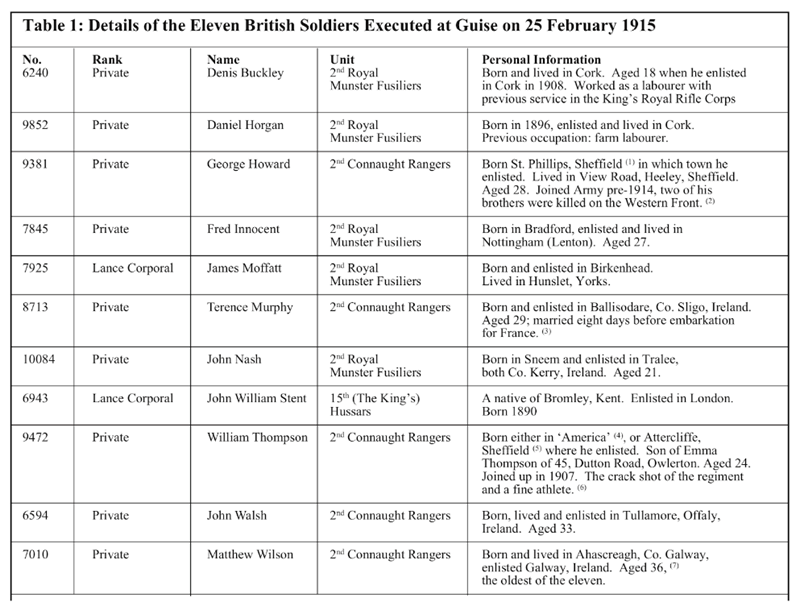

The fragmentary nature of the information about the soldiers makes it impossible to draw any firm conclusions. At first glance they appear to have been a typical cross-section of soldiers drawn from the 1914 Regular Army. Six were Irish, four or five were English and one was possibly born in America. These figures appear to reflect the heavy dependence of the British Army on Irish-born soldiers; this reliance had declined since the mid-nineteenth century when more than one-third of recruits were Irish(20) but they were still very important in 1914. As Holmes notes of the British Army in 1914, ‘There were Irishmen everywhere’.(21) The figures suggest that in turn Irish regiments were dependent upon English recruits. The eldest was Matthew Wilson who was 36; the average age was about 24: the youngest appears to have been Daniel Horgan who would have been 18 or 19. A 17-year-old is reported to have been in the group,(22) but no soldier of that age has been traced. Horgan was the youngest, but his stated age may be incorrect. His attestation papers are vague as to his birthday stating only that he was ‘born 1896’.
Perhaps it is possible to see in the composition of the group an element that contributed to the tragedy which was to befall them. It is obvious from Table 1 that there was nobody with any great claim to seniority based on rank, age, military decoration or service. Whatever small differences had existed may not have survived once the group was hiding from the Germans. Removed from the Army with its symbols, rituals and routines (uniform, drill, senior officers, pay, discipline) then any individual’s claim to formal status and authority based on the Army rank may well have evaporated. Lacking direction and control, and without an individual who could have taken and imposed the hard decisions that had to be made if any were to be saved, then perhaps this group was drifting towards disaster from the very start.
Formal command is only one source of authority. Perhaps one possessed the charisma to impose his personality on the group, but no trace of such a man survives. It is only at their last moment that any one of them steps out from the group and makes a personal mark, and this account cannot be verified. They truly were les onze anglais and not eleven individuals.
The Background
It is beyond doubt that these soldiers were stragglers from two encounters between the German and British Armies in the last week of 1914. These were at Le Grand Fayt and Etreux. Both the 2nd Royal Munster Fusiliers (2/RMF) and the 2nd Connaught Rangers (2/CR) were part of 1 Corps; 2/CR was part of the 2nd Division, 5 Infantry Brigade; 2/RMF were a 1 (Guards) Brigade battalion in the 1st Division. On the afternoon of 26 August 2/CR were deployed about two miles east of Landrecies; they had been detailed to act as rear-guard to the brigade’s retreat. Misinformed as to the Germans’ position, 2/CR was encircled by them in an area around Marbaix and Le Grand Fayt. They emerged with nearly 300 men missing. (23)
The next day (27 August) 2/RMF and two troops of the 15th Hussars were defending the crossings of the Sambre Canal between Catillon and Etreux, about six miles south-west of Le Grand Fayt. They were deployed along the road linking Bergues and Chapeau Rouge. They came under German attack during the morning. Orders to retire from Brigadier-General Maxse, GOC 1 (Guards) Brigade never reached them. They were left isolated as other units in the brigade on their flanks withdrew and by early evening their line of retreat across the canal to the relative safety of Guise had been severed. Surrounded by a much superior German force, they lost their CO, Major Charrier. His successor, Lieutenant Gower, surrendered at about 9.15 pm.(24) He was subsequently interned in Holland.(25)
From his internment he wrote an account of the battle and of its aftermath.(26) It appears from this that the Germans had considerable difficulties in locating the missing Munsters after the battle. Whilst he was their prisoner Gower observed that the Germans were still bringing in Munsters from the battlefield up to nine days after the battle. Using the information in Gower’s letter, McCance’s regimental history(27) and SDGW it is possible to estimate the number of Munsters who escaped the action and the subsequent German round-up. This is presented in Table 2.
Assuming 30 stragglers became lost before the battle of Etreux, then there were about 120 Munsters still on the run one week after the battle. Gower’s letter can be further used to estimate the minimum numbers of 2/RMF in hiding. He knew the numbers of prisoners and wounded (he uses the word ‘exactly’ to describe the number of wounded), but he could neither have known the number of dead; bodies would be scattered over quite an extensive area, others obliterated; nor could he have known how many were on the run. Gower estimated that there were 159 Munsters killed in action during the Etreux battle. With the benefit of hindsight it can be seen that that figure is incorrect. SDGW gives the number of RMF who died between 27 August and 4 September 1914 as 108. The difference of 51 between Gower’s estimate and the more accurate count in SDGW is probably a good indication of the minimum number of Munsters who went into hiding at the end of the battle. An alternative explanation is that Gower well knew that there were numbers of 2/RMF in hiding but writing from his place of internment he chose to conceal it by inflating his estimate of the number of dead.
It can be stated with some confidence that the numbers of 2/RMF missing one week after Etreux was between about 50 and 120. Anecdotal evidence supports the idea that there were considerable numbers of Munsters trying to escape. Beaumont, another soldier trying to return to the UK, describes a night passed in Edith Cavell’s shelter in Brussels in the spring of 1915. Of the fourteen or so soldiers there that night, ten were Munsters.(28)
Estimating the number of Connaught Rangers trapped behind the lines after the disaster at Le Grand Fayt on August 26 is more difficult. What is known is that of the 300 Rangers missing, 17 were killed(29) or died between 26 August and 4 September.(30) How many of the remaining 280 or so ended as PoW, on the run, or escaped to rejoin their units is not known.
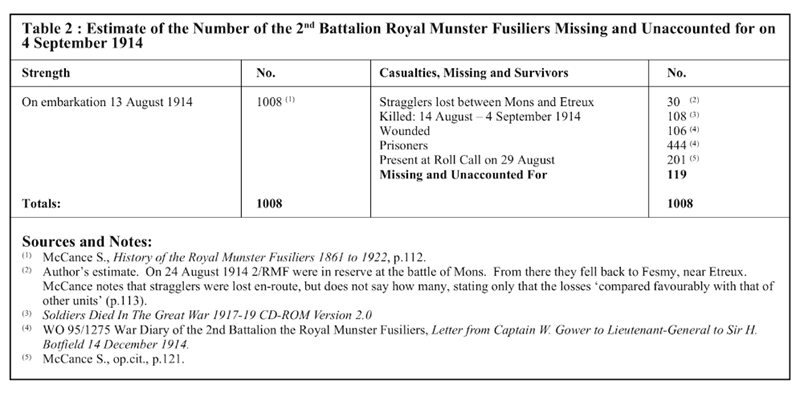
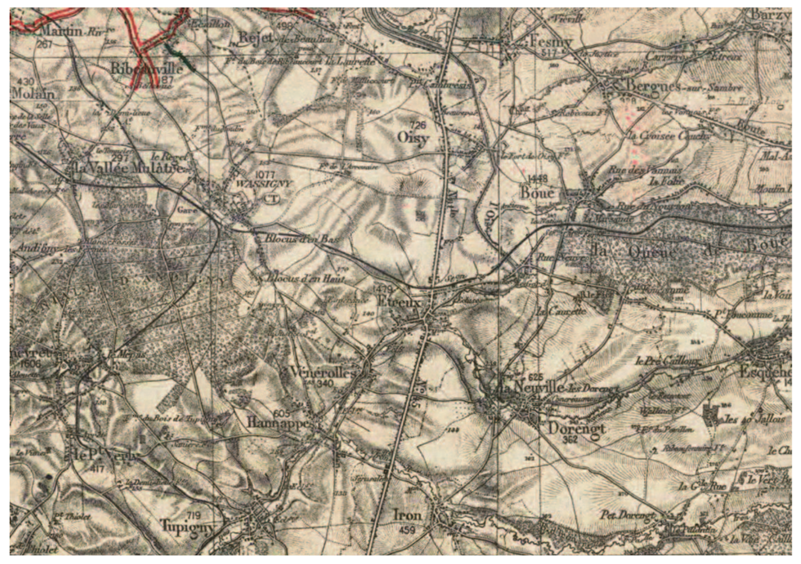
To the east, south of Wassigny, can be seen the Andigny Forest. Both of these forests provided shelter for Allied soldiers behind the lines. The Munsters held the line on the road from Bergues north to Chapeau Rouge, just off the map, and fell back to Etreux. Le Grand Fayt lies just to the north of the map; Guise just to the south. (Extract from No.59 (Sept 1917) Straßenkarte de 2 Armee. Gedruckt v.d. Zentral-stelle d. Vermessung dienste der 2.Armee. Source: Army Trench and Operations Maps from the National Archives, CD-ROM published by the Naval and Military Press: map of Arras-Valenciennes-St. Quentin area in General 2nd, 4th, 6th and 17th Army folder)
Such large numbers of missing soldiers were made possible by both natural and man-made factors. The natural factors can be found in the nature of the countryside. The area in which both of these battles took place is quite unlike the plains of Picardy, Champagne, Flanders and the Somme where the bulk of Western Front fighting took place. This is L’Avesnois, where the last vestiges of the Ardennes meet the plains of north-west France. Now, as then, it is a combination of lush, undulating, well-watered small fields, surrounded by thick hedges with few gaps, interspersed with great, dense forests such as Nouvion and Mormal. The term bocage is often used to describe the countryside and indeed the region is much more like Normandy than the Nord and Pas-de-Calais. Further, in late August the crops would have been well grown but unharvested due to the war, providing escapees with further cover.
Nature sometimes receives a helping human hand and the German Army provided this. First, there is some evidence that at least one of the eleven soldiers, William Thompson, spent some time in German custody. According to a posting on The Great War Forum(31) Thompson’s great- grand-daughter is quoted as saying that he, along with other British soldiers, was ‘taken prisoner by the Germans at a place called Bo[ué].(32) They were taken to a forest nearby but it was bombed by the British and in the woods till October the 21st’. This evidence shows that German prisoner security arrangements were possibly lacking, but as some of the eleven soldiers were armed when they were finally captured, it is likely that not all of them passed through German hands.
Second, the Germans forced many local residents into the forests around Nouvion. McPhail(33) cites a diary kept by a M. Leduc, a local headteacher, in which he describes how, on 24 August, the Germans entered Nouvion and set fire to the town as a reprisal for alleged sniping by the locals against the Germans. Whether or not there had been such attacks is not clear; possibly the Germans were fearful of a repetition of the damage inflicted by francs- tireurs, or civilian sharpshooters, on German forces during the Franco-German War of 1870- 71. The locals, and the refugees who had taken shelter with them, were forced to move into the fields and the forest. This happened three days before the battle at Etreux and two before that at Le Grand Fayt. Thus any fleeing British soldier would find camouflage in numbers. The sight of people living rough in the forests around Nouvion would not attract any special German attention, nor would anyone, given the presence of numbers of Flemish-speaking Belgian refugees, who was unable to speak French. In this sense the Germans had already prepared relatively safe havens for the British soldiers before the two battles had started.
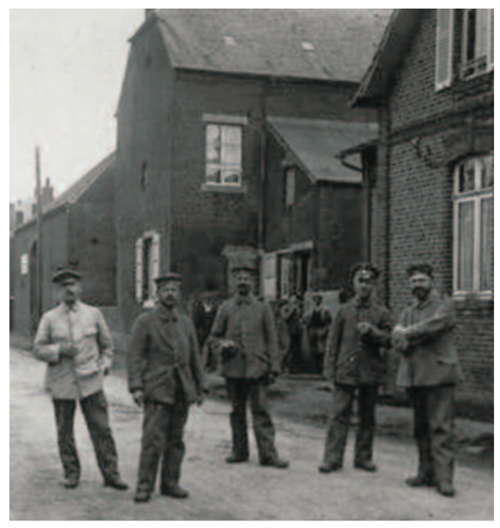
In late August and early September the woods and fields were hiding Belgian, French and British soldiers, as well as refugees. A local woman, Aline Carpentier who was, according to McPhail an ‘assiduous observer and diarist’; noted in her diary entry of 4 November that, ‘men hid in the woods and abandoned houses torn between remaining concealed and trying to rejoin their units.’(34) On the same day her son found a group of twenty British soldiers hiding in the undergrowth. Local villagers appear to have kept soldiers in hiding supplied with food and acted as guides, scouts and lookouts for them.(35)
The German reaction to these unwanted guests was initially tolerant. Any Allied soldier could come out of hiding and surrender and expect to be treated as a PoW. The Germans began issuing a series of proclamations giving Allied soldiers a period of grace (usually one or two weeks) in which to surrender. This could indicate a growing concern on the part of the Germans about the number of Allied soldiers on the run behind their lines. Numerous pronouncements appeared stating that after a period of grace any British soldier caught in or out of uniform would be regarded as a spy and shot. Smith cites four such proclamations: 2 November 1914, 8 November 1914, 1 March 1915 and 15 October 1915.(36) McPhail states that according to German pronouncements, any Allied soldier taken after 4 December would be shot.(37) A reward of ten francs per head was offered to anyone turning in an Allied soldier on the run. This was hardly exorbitant, about the same as the average daily wage for a skilled worker in France in 1913.(38) The small amount of reward money suggests that greed would not determine whether or not informers turned in British soldiers.
German attitudes were not the only factor to change. Spending late August and September in the woods and fields, fed and guarded by villagers could have been an idyllic experience. Yet as late summer gave way to the rain and mists of a cold Aisne autumn, many soldiers felt forced to seek somewhere warmer, drier and where food was more assured. This need appears to have been a compelling one, which forced the eleven British soldiers into the arms of the villagers of Iron.
The ‘Eleven’ arrive in Iron
The first contact came on 15 October, 1914 when Vincent Chalandre came across nine British soldiers in the fields near Iron, a small village of 500 souls about three miles to the south of Etreux. The soldiers, still in possession of their rifles, were scavenging for raw carrots and other root crops.(39) They asked Chalandre for bread. Chalandre was a retired silk weaver living in Iron but he worked as a casual labourer for Monsieur and Madame Logez, smallholders who owned a mill in the same village. Touched by the plight of the nine, reduced to rooting in the fields for vegetables, Chalandre resolved to help them. Monsieur Logez had suffered a stroke and appears to have been mentally incapable; in these circumstances Madame Léonie Logez had taken over the running of the family business. As well as her husband, she had a son, Oscar, aged 16, and daughter Jeanne, aged 15, to help her.
Cometh the hour, cometh the woman. For Walton, who met Madame Logez several times as part of the research for his article he was:
greatly struck by her boundless energy even after the cruel trials that she suffered as a result of her devoted care to the British soldiers. It was a rare experience to listen to this wonderful French woman as she recalled in a most matter- of-fact way, how she responded to M. Chalandre’s request for aid: “How could I do otherwise than help these poor fellows who were lost and starving?” she asked. “It was my simple duty.” She set about the task of saving the pauvres enfants, as she continually called them, with rare resolution. (40)
Les onze Anglais describes her as a ‘dynamic woman and a good patriot’.(41) Her first response was to organise shelter for the nine soldiers in a large hut belonging to her, located in fields she owned. This was very dangerous as there were Germans billeted in the village. Despite the risks involved she organised food supplies for them, using her cover as a smallholder who owned cows. She took soup and bread hidden in a milk bucket to the hut in which they were hiding. She raised no suspicion with the resident Germans, whom she often met on her errands of mercy to the fields. This arrangement lasted for five days. On October 20 the weather deteriorated and Madame Logez decided that the nine soldiers should take a hot supper and spend nights in her mill, a little to the north of the village. By day the soldiers would return to the hut in the fields very early in the morning, returning only at nightfall. This system continued until 1 November when it was decided to split the sleeping accommodation. Five soldiers should sleep at the mill; four would go to Chalandre’s house in the village itself.
Whether they were in the hut or at the mill, Madame Logez remained responsible for feeding them. Her smallholding enabled her to move around carrying meat and cereals; her mill gave her access to flour, which she used to bake bread for the soldiers. She organised a network of women, rendezvous and pick-up points to furnish the considerable supplies demanded by the daily task of feeding the nine soldiers. In this she was helped by Vincent Chalandre’s ‘brave wife’,(42) their ‘heroic’ daughter Germaine, aged 20, (43) and a Madame Vigèle who secured them clothes, milk and food. A Mme Jules Dufour also helped; she ferried food and other supplies from the house of a woman who had died during the invasion.(44) Madame Logez, Madame Chalandre and Germaine remained responsible for taking the food to the soldiers in their hut. Madame Chalandre had four other children apart from Germaine. These were: Marthe, aged 14; Marcel, 10; Leon, 7; and Clovis, 16.(45) It was Clovis who, on 6 or 7 December discovered two more British soldiers hiding in the woods. Madame Logez accommodated them with alacrity observing only that, ‘If I can keep nine, I can keep eleven.’(46)
The first portent of doom arrived on 15 December when forty German military police arrived on motorcycles at the mill. Madame Logez, displaying considerable bravery and nerve, delayed them just long enough for her daughter, Jeanne, to warn the soldiers who were asleep in the loft to escape through the rear. They managed to get clear of the mill, crossed the river and hid in a copse on the other side. The Germans surrounded and then entered the mill. They searched it and found nothing save some flour and supplies, and no indication of the English presence. Walton states that the soldiers used this escape route ‘frequently when in danger of discovery’(47) which suggests that this was not the only occasion the soldiers had a close call. In a small, tightly-knit community, where many people were related and where most people knew a great deal about other people’s business, many must have known of the presence of the soldiers amongst them.
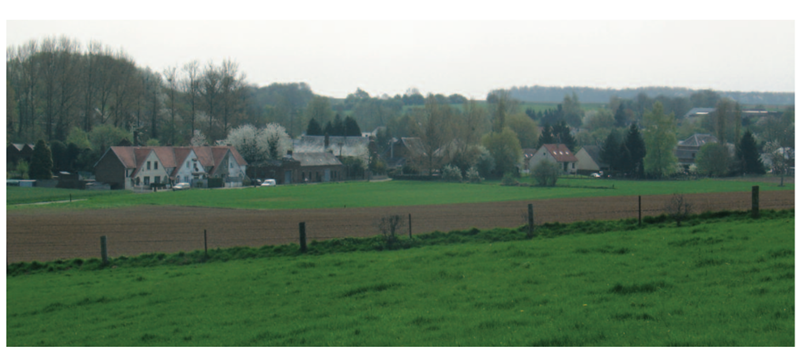
It is possible that the raid of 15 December was the result of information received by the Germans. On the other hand Madame Logez appeared to think that it was a ‘perquisition,’ or compulsory confiscation of food and supplies, which the Germans routinely exacted from the French communities they occupied.(48)
In the village lived a woman named Blanche Maréchal. She was married and she was generous with her sexual favours. Her lovers included German soldiers, or as Les onze Anglais puts it, ‘the Germans, too, wallowed in this filth.’(49) Another was Clovis Chalandre, the 16-year-old son of Vincent Chalandre. There was some very indiscreet pillow talk during which Clovis told her about the British soldiers. Blanche told her husband who made his own enquiries, and he stimulated gossip. One way or another the news reached one of Blanche’s other lovers, Bachelet, a 66-year-old veteran of the Franco-Prussian War of 1870-71.
Clovis, who appears amply to justify Les onze Anglais’ description of him as a ‘stupid youth’, was jealous of Bachelet.(50) On the night of 21 February Clovis went to M.Maton’s brasserie where Bachelet lodged and threw stones at Bachelet’s window. Bachelet’s response shocked Clovis. Bachelet shouted, “You’ll pay for this; tomorrow I am going to inform on you and the English! - you will all be shot!” Clovia returned home - and told no one. Bachelet was to as good as his word.
On 22 February Bachelet, driven by ‘a thirst for revenge, and a madness born of senility’(51) went to the German military headquarters in Guise. There the Rear-Zone Commanding Officer, Lieutenant-Colonel Waechter and his adjutant Kolera, received him. To these two, Bachelet denounced the soldiers and those who were sheltering them. On the same morning Madame Logez, who suspected nothing, went to the same German military HQ. This was a regular visit she made to renew her trader’s pass, a permit which allowed her to move around freely. This document was usually granted to her without question, but this time she was greeted very coldly and told that she would have to stay there until the evening. The German military HQ was unusually busy. While she was waiting, though an open door she saw Waechter and Bachelet in the next room. Bachelet blanched when he saw her and he indicated that he did not wish to say any more in front of her.
Waechter began his preparations to take the British troops. All that day German troops passed up and down the road between Guise and Iron. In the afternoon Waechter and Bachelet boarded a small convoy of two cars and a lorry in La Place des Armes in Guise and set off for Chalandre’s house in Iron.
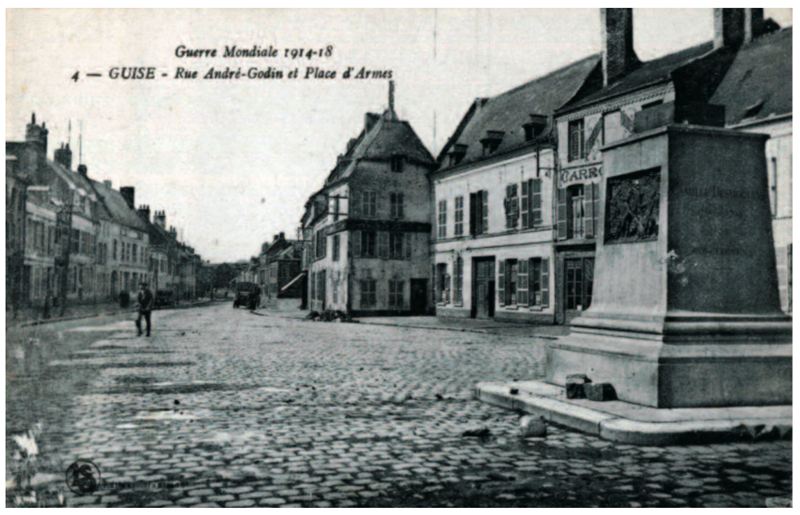
References
- Walton, Herbert A, The Secret of the Mill in The Wide World Magazine c.1928 p.414.
- Macintyre, Ben, A Foreign Field (Harper Collins, 2001)
- McPhails, Helen, The Long Silence: Civilian Life under the German Occupation in Northern France ( I B Tauris, 1999)
- Macdonald, Lyn, 1914 (Michael Joseph, 1987)
- McPhail, op.cit.
- Reed, Paul: Irish Soldiers Executed 1914-1918. invisionzone.com/forums, 2005 [cited 23 October 2006]
- TNA WO 329/2957: Prisoner of War Helpers Medal
- McPhail, op.cit. P.137
- Wolfe, Tom, The Right Stuff (Vintage, 2005)
- CWGC Casualty Details [Cited 26 January 2009]
- Soldiers Died in the Great War (SDGW) CD-Rom Version 2.0 Naval and Military Press.
- TNA WO 363. War Survivors and War Dead.
- Les Onze Anglais d’Iron published by R Minon, Guise, no date
- Walton, op.cit.
- Smith, D, Shot by the Enemy, at the Chateau. Gun Fire (Journal of the Yorkshire and Humberside Branch of The Western Front Association). C. 1997 (44)
- A Notebook of a Guisard, in L’Aisne, 22 April, 1922.
- SDGC, op.cit
- CWGC op.cit
- TNA WO 363, op.cit.
- Skelley, A R, The Victorian Army at Home: The Recruitment and Terms and Conditions of the British Regular 1859-1899 (Croom Helm, 1977), p.298
- Holmes, R, Riding the Retreat: Mons to Marne - 1914 Revisited (Pimlico, 2007). P.32
- Smith, op.cit.p.37
- Edmonds, J E Military Operations: France and Belgium 1914: Mons, the Retreat to the Seine, the Marne and the Aisne August-October 1914. History of the Great War (MacMilan, 1937), pp202-3.
- Edmonds, ibid, pp225-6.
- Cox 7 Co (Compliers), List of British Officers taken prisoners in the various theatres of war between August 1914 and November 1918. No date.
- TNA WO 95/1275 Letter from Captain W Gower to Lieutenant General Sir H Botfield, 14 December 1914.
- McCance, C S History of the Royal Munster Fusiliers: Volume 11 From 1861 to 1922 (Disbandment) Naval and Military Press. No date.
- Beaumont, H. Old Contemptible (Hutchinson, 1967). P.147
- Today nine British soldiers are buried in Le Grand Fayt Communal Cemetery in a common grave with three German soldiers under a headstone erected by the German Army. Of the nine, six are either named or unnamed 2/Cr; the remaining three unknowns are almost certainly Rangers’ casualties of 26 August 1914.
- SDGW, op.cit
- War Graves, 10 Executed British Soldiers. 2005 [Cited 23 October 2006].
- Boué is a village about two miles east of Etreux - see Map 1.
- McPhail op.cit. p20
- Loc cit
- McPhail op.cit. p29-31
- Smith, op.cit. p.44
- McPhail, op.cit. p35
- Ibid, p36
- Walton, op.cit. P415
- Loc cit
- Les onze Anglais d’Iron. Op.cit. p1
- Walton, op,cit p415
- Ibid, p417
- Les onze Anglais d’Iron. Op.cit. p2
- Smith, op.cit p43
- Walton, op.cit. p417
- Loc cit
- Walton, op.cit, pp417-18
- Les onze Anglais d’Iron. Op.cit. p2
- Ibid. p3
- Loc.cit





